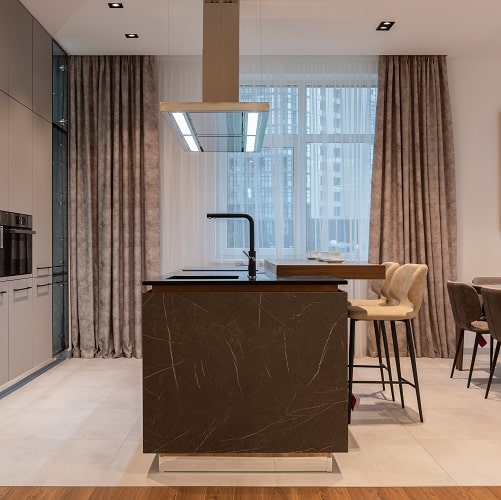Spiffy Speak
SLIDING GLASS DOOR CURTAINS: IDEAS & TIPS
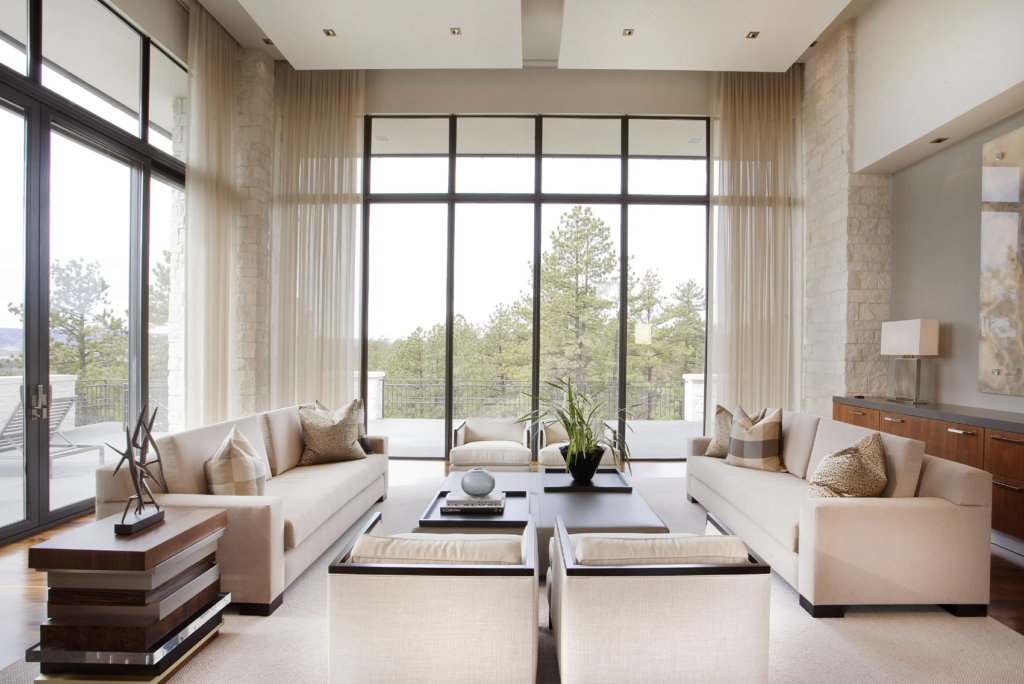
Sliding glass doors are wonderful architectural features that help us stay visually connected to the other side and save considerable space. When placed on external walls, they frame the views, let in light, and make the space look larger. As room dividers, they make the rooms look more spacious. If you’re planning to dress up your sliders in curtains, this blog will be a time well spent. Whether your goal is privacy, light control, elegance, or all of the above, we’ve got fantastic styling tips for your sliding glass door curtains. Read on and enjoy!
Order custom sliding door curtains and drapes from Spiffy Spools online in any size. Pick from over 3,000 fabrics and patterns!
Challenges with Dressing Sliding Glass Doors with Curtains
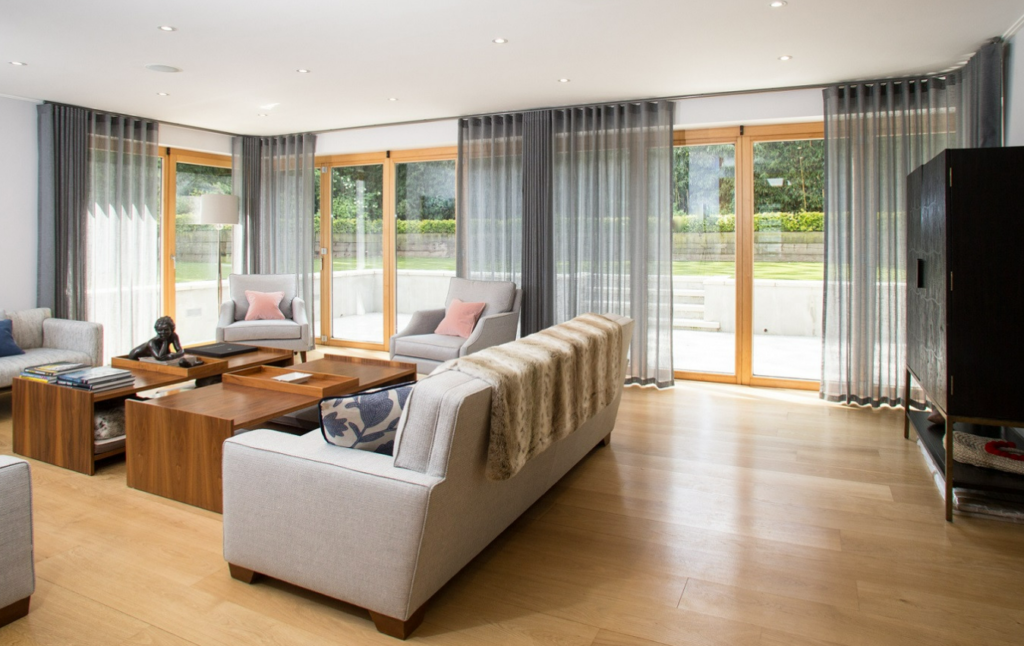
While half the job is done when you have decided which treatment you want for your sliding glass doors, you will soon know that the decision-making process has just begun. You need to make small and big decisions throughout the styling process which will ultimately land you with the drapes that you’ll be proud of for the rest of your life. There are several factors to consider when buying drapery, and to get you start, here are the top factors you must spend some time addressing while shopping specifically for sliding glass door curtains:
- Set a Goal: Begin by setting the goal of the project. Define the purpose of dressing your sliders in the first place. Is it to accord privacy, or to cancel the sun glare on the TV, or are you merely looking for an excuse to layer your sliders with cozy textiles to make them an engaging focal point? Once you answer this question, you’ll know whether to go for a highly functional window treatment for your sliding doors or a decorative one that simply furthers your aesthetic vision.
- Remember the Room’s Purpose: Keep in mind the purpose of the room when you work on the details of the drapery. Is it a bedroom where everything needs to be hushed for good sleep or a media room where light might be unwelcome at movie time? Or, is it a family room where you might want your time together without being investigated by prying neighbors? Or, are you seeking to cut off the visual connection with the other side of the doors to forge more focused activity at the reading nook, homework station, or home office?
- Factor in Placement: Also, consider where your sliders are situated – are you looking for curtains for patio doors on the external walls opening to a patio or are the sliding doors present on the internal walls as room dividers. If the sliders are external, you’ll need colorfast and hardy fabrics that will stand up to the elements. If they are room dividers, your drapes have to be presentable on both sides. They must also sync with the decor in both rooms. The choice of fabric and the heading style will be largely influenced by this aspect.
- Consider the Room’s Layout: Consider how your draperies will work with the layout of the space around the sliders. Since a large passageway is involved, you need to make sure that the curtains have their own space, and more so if it’s a high-traffic zone. You need to avoid the drapes flaring and puddling at the bottom to cancel tripping accidents, especially if you have little kids and pets.
- Mind the Stack: Check whether you have sufficient wall space on the sides to stack the curtains when they are not in use. If not, the drapes will partially cover the doors when stacked back. And if you need perfect clearance, there are things to keep in mind while designing them.
- Insulate: Glazed doors come with a ton of tempting goodness, but not without some limitations. Come freezing winters, you may see some heat escape through your sliders. And that speaks eloquently in your power bills too. And, if your sliders are placed on the external walls of a bedroom or nursery, this issue can’t even be ignored. You need highly insulative draperies or even double-layered window treatments to take off some load from your overworked heaters.
- Sync with Decor Style: After all of the above functional necessities are addressed, your draperies must also voice your decor style aptly. The palette, pattern, texture, weave, heading style, hardware, and accessories should rhyme with the overall design story of the room.
While the above-detailed aspects of designing sliding glass door curtains might seem overwhelming at first sight, they are not so in reality if only you have the right information and guidance accompanying you. So, if you’re ready for the next step, we’ll take you through some fantastic ideas and tips that will help you achieve this goal.
Dressing Up Your Modern Architectural Gems Worthily
Curtains are one of the finest window treatments that sliding glass doors can be dressed with. They provide seamless coverage, foolproof privacy, higher insulation, and versatility for a semi to total light blockage. And while fulfilling these functions diligently, curtains and drapes also double up as beautiful decor accessories and add a hyggelig dimension to the space. Unlike the big box store finds, custom drapes will truly elevate your space – bringing in your favorite color, a sumptuous feel, and a personalized touch.
So, three cheers for the right choice!
But, there are so many types of curtains that you can consider, and knowing what’s best for your sliders takes some research. So, let’s take you through some very handy design tips so you can make your sliding doors the prettiest spot in the room.
Choose the Right Material
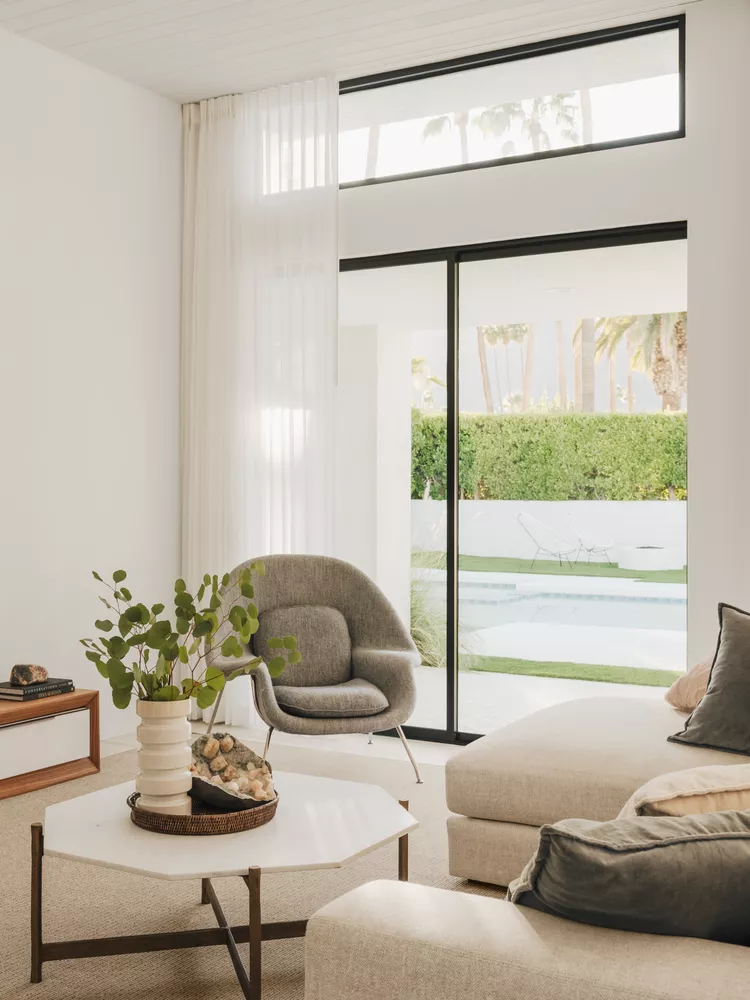
The first decision you’ll make when shopping curtains for your sliders is the drapery fabric material. To get this one right, discern the level of light control you wish to achieve and the style you’re going for as regards formal, semi-formal, or casual. The clues to the right fabric partly lie in there.
If you like to make the most of the light pouring in through these grand picture windows, consider sheer or loose woven linen drapes. Air and light will be filtered into the room even when the drapes are drawn, still providing you privacy during the day. If it’s a very casual space, you can opt for loose woven drapes such as Cloud White linen drapes or White Breeze sheer drapes that help to keep the place bright and airy both by their making as well as their palette.
But if your sliding glass doors are placed in your bedroom or nursery, this type of light control may not be wise. Then you may consider blackout drapes that contain heat, light and sound effectively, assuring you with a sleep-friendly ambiance. Consider blackout drapes such as Desert or Neer. Or, choose any fabric from our extensive collection and simply add blackout lining to avail of the same benefits as a blackout drapery.
Non-sheer, non-blackout curtains are an in-between solution for spaces where a moderate level of light is welcome. Neither do they filter in the light like sheers nor block them completely like blackouts. And they guarantee privacy during the day as well as at night.
If you’re looking for non-sheer curtains for a semi-formal or informal room, consider tight woven linen drapes like Nacl and Taembili or cotton drapes such as Elevado and Quarry Pond. If your sliding glass doors are part of a formal area, consider more high-end fabrics such as velvet and silk. Depending on what suits the overall decor of the space, opt for draperies such as Gypsy Plum or Cigno.
SHOP NOW: CUSTOM SHEER CURTAINS & WINDOW DRAPES FROM SPIFFY SPOOLS
Choose a Befitting Palette & Pattern
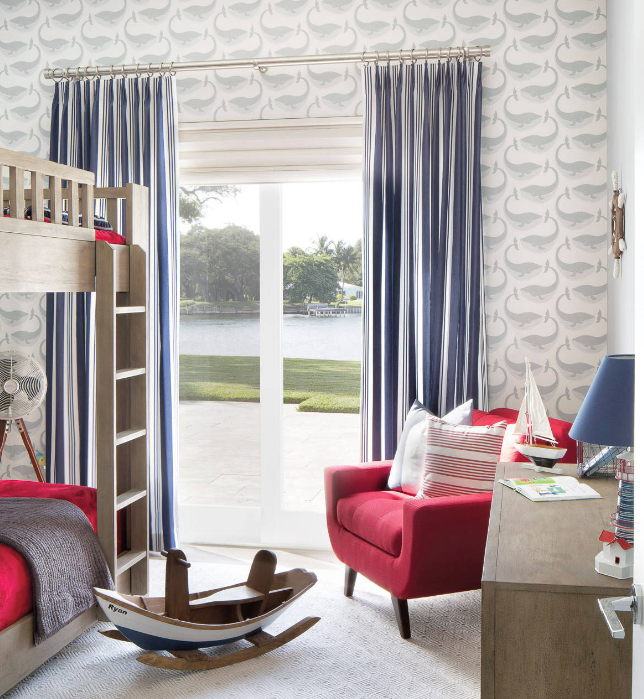
Another key design decision to be taken for your sliding glass door curtains is regarding their palette. The colors should ideally pick up from the rest of the decor for cohesiveness.
If you want your drapes to recede into the background, match them to the wall colors. When the curtains are stacked to the sides, they’ll almost seem to be absent.
But if you want your drapery to be the star, consider your overall room palette and pick drapery in colors that will stand out. You can feature the primary and secondary hues or tie up all the accent hues. Since curtains occupy much optical space, be assured that their colors will definitely make a huge impact on the overall scheme.
Close at hand with the first decision, comes the second – whether to go for plains or patterns. It will mostly depend on your personal taste, however, do take the general design principles into account when you decide.
Patterns are eye-engagers by default and it’s both a boon and a bane. If your room is covered with solid-colored surfaces, it can look disinteresting, even intimidating. Here, patterned drapes can be refreshing breathers.
Whereas, if there is a ton of patterns on surfaces that take up huge optical space such as furniture, walls, and floors, patterned drapes may make the space look busy and cluttered. What you need to do is to strike a balance between plains and patterns so that both elements may complement each other.
So, for example, for sliders in the living room, you can go carefree for patterned drapes if your couch is solid-colored and the area rug features simple patterns like stripes or a textured finish. Consider floral and botanical printed drapes like Blue Penny and Erlensee Spring if your sliders are opening to a garden to match its vibe. Or go for plaid curtains like Lattice that call upon a nostalgic country style.
If you love to introduce patterned drapes but fear that they can overturn the solid-pattern ratio of your decor, consider quiet patterns like pinstripes with subtle contrasts such as in Pale Shadow, or ombre drapes like Royal Wedding and get the best of both worlds.
Interestingly, you can also use patterned drapes to boost the vertical dimension of your sliders. This trick works well to elongate the space in low-ceiling rooms. It is achieved by selecting upward-directing patterns like stripes, climbing vines, arrows, chevrons, and so on.
There’s a superabundance of patterns that you can introduce to your space through drapery, so do browse our patterned drapes collection for more inspiration.
Select a Suitable Heading Style
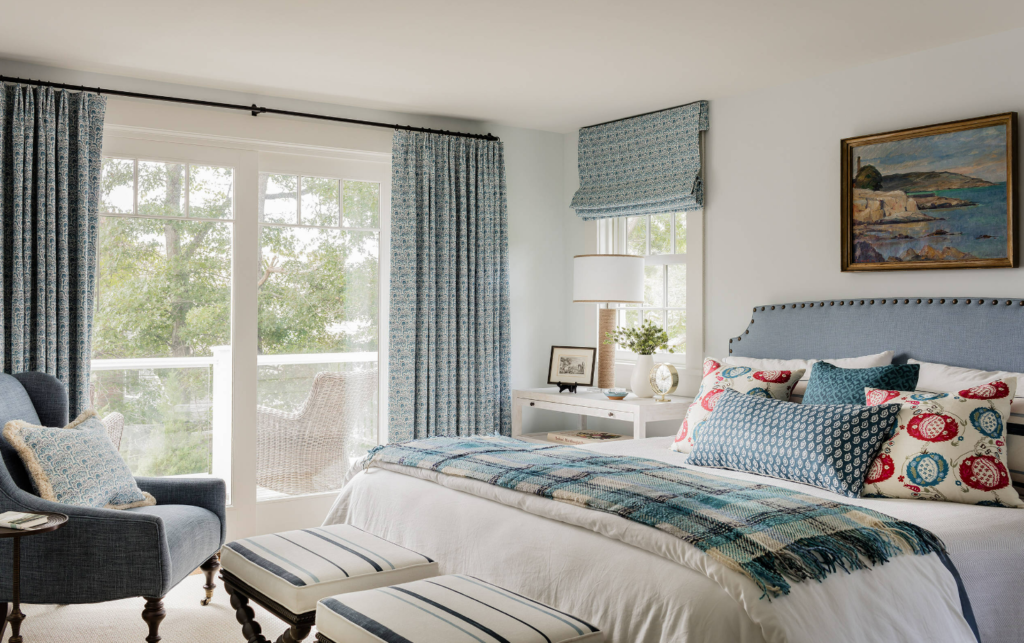
All curtains might look the same to an untrained eye, but on observing the header closer, you begin to see the differences. The header or pleating style of your drapery dictates how the curtains drape, fall, and operate on the drapery pole.
There are over a dozen curtain heading styles on offer and you can surely find one that fulfills your need and aesthetic vision. From architectural ripplefold curtains to lazy-looking tie tops and highly decorative pinched pleats to non-nonsense flat panel tops, you have curtain styles that fit any mandate perfectly.
Whether your drapes are functional or decorative will also have a say in the selection of the heading style. If you plan on operating the curtains and your sliding doors often during the day, choose heading styles that incorporate rings or grommets. They slide easily, making it an unfussy chore.
On the other hand, if it’s generally very drafty or you’re going for decorative draperies to frame the glass doors with no functional relevance, you must look for curtain styles that don’t budge easily. Think of styles that use fabric pockets or loops such as rod pockets or back tab curtains.
Another aspect to bear in mind is the overall decor of the space. If it’s a formal setup, any one of the pinch pleats styles would be ideal. Whereas, an informal arrangement would benefit from more casual styles such grommet tops, flat panel tops, or tab tops.
But while chasing the most pretty drapery style, don’t let their stacking room demands be lost on you. Some styles like box pleats and pinch pleats need more stacking room than others. If there isn’t enough space on the sides of the doors, the doors will be robbed of some space by the stacks. So, go for other styles that look elegant but require lesser stacking space.
Also, factor in the type of light control you’re looking for. Since glazed doors bring in a lot of light, a sharp streak of light hitting from the top of the curtains can be annoying in a bedroom, for example. Then you need curtain styles that have compact headers and avoid those with loops such as tab tops.
So, choose your heading style based on your aesthetic vision, functional needs, and frequency of use.
Consider the Rear Side View
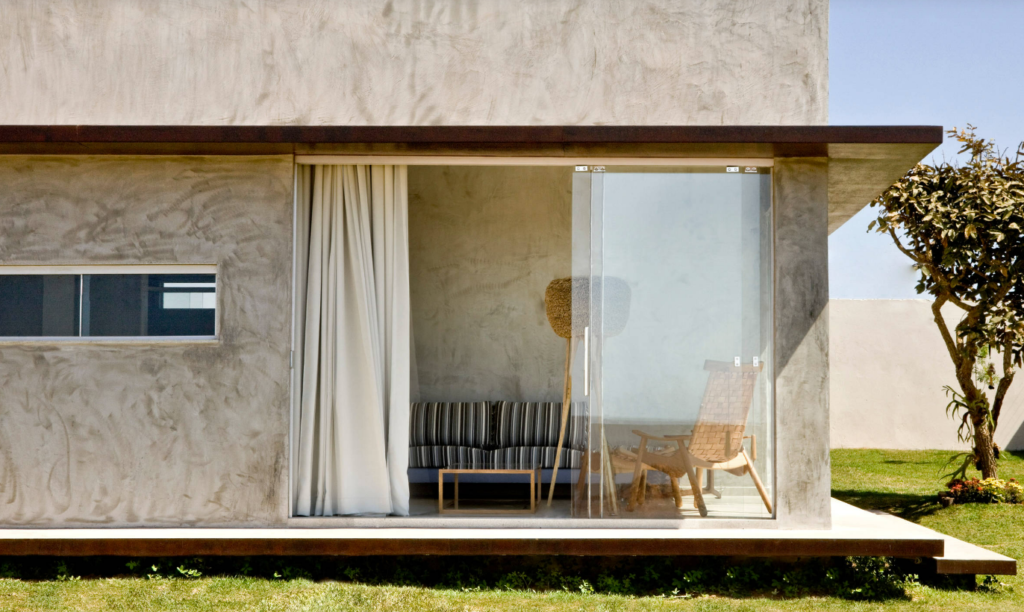
Whatever design decisions you take about your sliding glass door curtains, never fail to account for this point in your thought process: your curtains are going to have a role to play in the decor of both sides of the space – especially if your sliders are placed inside your house to serve as space dividers.
The safest zone for drapes that have to work for two spaces is solid neutrals. This is because the color composition will likely be the same on both sides of the fabric, but you might need to verify it. Since neutral hues can be blended easily with any color palette, they can also gel with the decor of both rooms easily. Alternatively, you can also choose a color that is common between both rooms so the drapes will match both spaces equally.
But if you like to introduce patterns to the space, make sure that the patterns show at the back with the same level of color saturation. And, avoid embroidered fabrics altogether unless they have show-worthy patterns on the reverse side.
Similarly, when you choose the lining, bear in mind that it is the color of the lining that will show on the other side. So, curtains with privacy lining from Spiffy Spools will look white from the other side and those with blackout lining will look pale grey or beige on the other side. If these colors don’t work well with the scheme of the other room, specify the color you want beforehand in the order, or skip lining the curtains.
While it doesn’t matter much when you are dealing with an external door like a patio door, you must be mindful of the rear-side view when selecting the heading style for internally-placed door curtains. Unless your curtains are hung fairly high above the trim, their heading tapes and hems are going to show on the other side. So you may wish to avoid curtain styles that have their rings/clips/loops visible at the back of the header such as the pinch pleats. Whereas heading styles such as flat panel tops, tab tops, grommet tops, and rod pockets have a more presentable look at the back of the header.
Whether it’s about finalizing the material, palette, pattern, or heading style of the drapes, make sure that the view from the rear side syncs with the decor on the other side too. And you’ll be on top of the game.
Decide on the Length
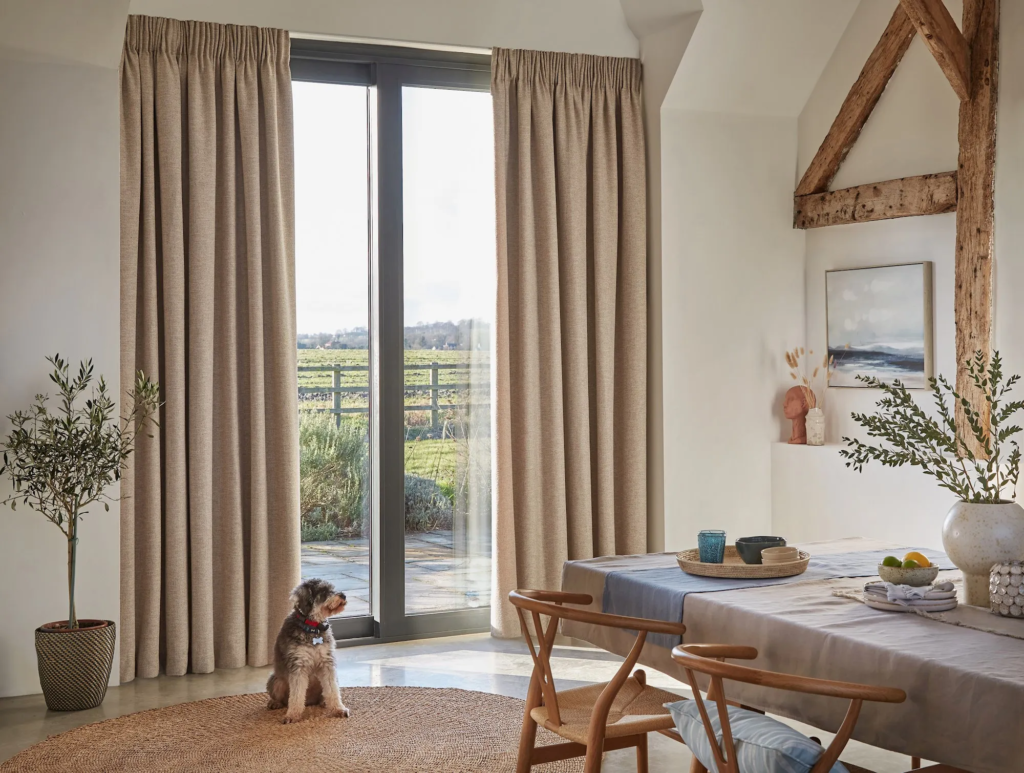
While there’s no debating on your curtains being floor-length since the sliders are doors, there are other details to it too.
First of all, decide from which point on the wall you will hang them. If there’s a bulkhead above the doors, hang the curtains right below it without leaving a gap. If the wall above the window meets with the ceiling without any obstruction, you can go for ceiling-to-floor drapes. These look classy and make the space feel large by wooing the eye upward. So, decide the starting point based on your preferences and architectural features.
Then, decide, where you want the curtains to stop. You can get them done in the ‘float’ position, that is, stopping an inch above the floor. It’s practically convenient as the bottom will not get soiled or frayed easily. It is also beneficial for high-traffic zones and for homes with little kids or pets who may get entangled in the drapes.
The next possibility is to hang the drapes in a ‘kiss’ position – lightly touching the floor. This looks more luxe and elevated than the previous one and obstructs light from breaking in from under the curtains.
The third option is to break-puddle the curtains. In this case, the curtains will touch the floor and then extend an inch on the floor. And the fourth option is to let them touch the floor and then puddle on the floor with an extension of about 6-16 inches. Both these lengths look extremely luxurious and are best applied to decorative drapes that will never be operated. That way, you can avoid them getting worn out from being dragged.
How long your draperies should be highly depends on the look you’re going for and the frequency of operation you envisage. If you will use your curtains often, the float position is ideal for fuss-free operation and the longevity of your drapes. But if they are stationary decorative additions and you don’t have to worry about pets and kids messing up with them, you can let them puddle on the floor without a sweat.
READ MORE: FLOOR-TO-CEILING CURTAINS: A COMPLETE GUIDE
Determine the Fullness Factor
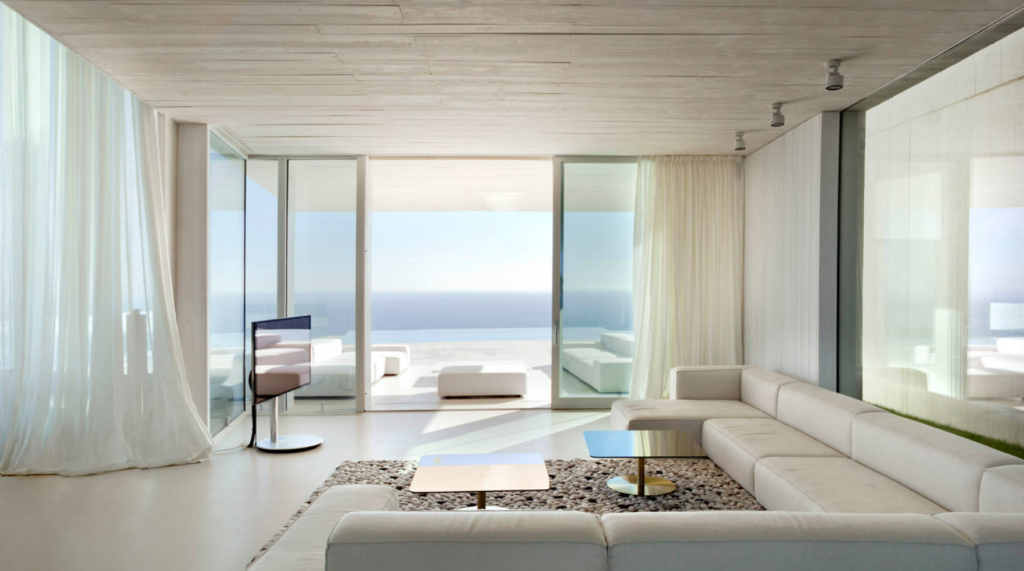
Drapery’s highlight feature is its contoured frontage that speaks of abundance, luxury, and elegance. The gently rounded, rich pleats and gather goes a long way in softening the space and making it look comfortable, both to the touch and the eye. Additionally, for glass doors, the generous use of fabric in the draperies would also add to the insulative quality of the windows.
The proportionate width of curtains in relation to the width of the window is referred to as the fullness of drapery, and we typically recommend a minimum of 2x fullness. What does that mean?
To give an example, if the doorway is 100 inches wide, we recommend going for a single curtain panel of 200 inches width or for two panels, each 100 inches wide – giving you 2x curtain width in proportion to your doorway width.
However, in the case of doorways, we advise clients to remember that the wider you go with the panels, the heavier they might get to operate. Whereas, less yardage of fabric translates to less stacking room, less weight, and easier movement on the drapery pole/track to clear the passageway.
So, 2x fullness is the maximum recommended for frequently used doors. If you envision your drapes being operated several times a day, or if you have no space around the glass doors to stack the curtains, you may also reduce the panel width up to 1.5x fullness.
Sheer drapes may call for an exception to the above however. Since they are gauzy, it can take up to 3x fullness for sheers to provide better privacy. And since they are lightweight, this abundant use of fabric does not pose any challenge to their smooth operation.
Take your decision based on the aesthetic statement you wish to make with your curtains and the frequency of their usage. For further reading on how to measure and decide panel widths, do visit our Drapery Sizing Guide.
Choose the Number of Panels
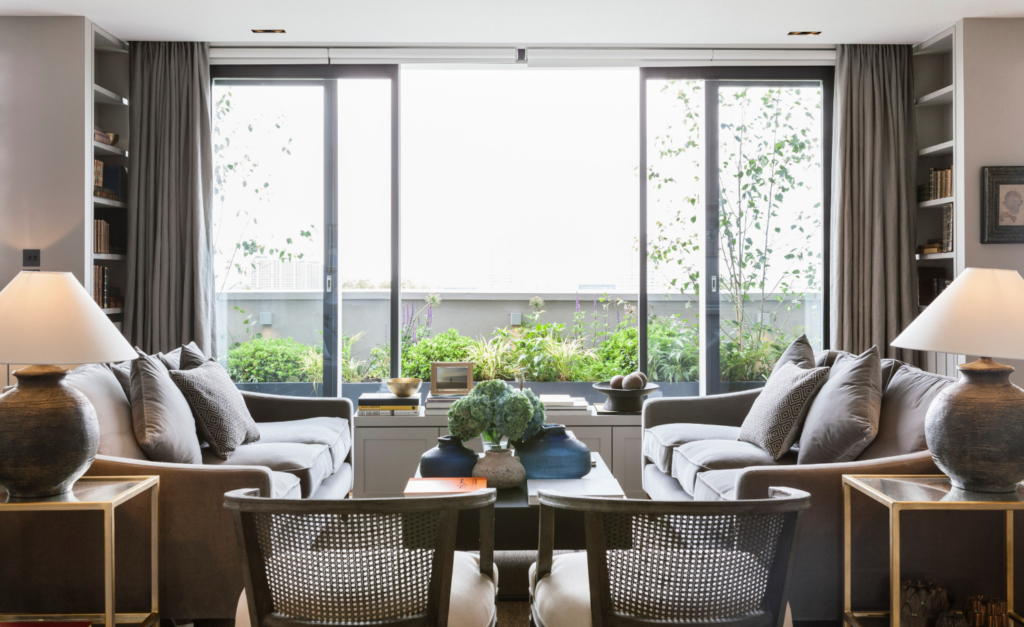
While curtains are usually designed with double panels and stacked to both sides, opening in the middle, some sliding doors might call for an exception. The type of sliding door you have can help determine the best way to hang your drapery.
If you have a two-way sliding door, going the usual way with a pair of curtains is ideal. It helps to frame both sides with a symmetrical balance. But, if you have a one-way sliding door, consider installing one-way draw single-panel drapery. The idea is to clear the side that is meant for access so that the curtains never come in the way. For a finished look, mount an elegant holdback on one side and let your curtain fall in a luxurious swag when pulled back.
Also, if you want, you can go for multiple panels of narrower width if that helps to reduce the weight or ease the maintenance. It also lends an opportunity to design your sliders with two types of curtains alternating each other for a more refined designer look if that is the vision you are chasing.
Invest in the Right Hardware and Position it Correctly
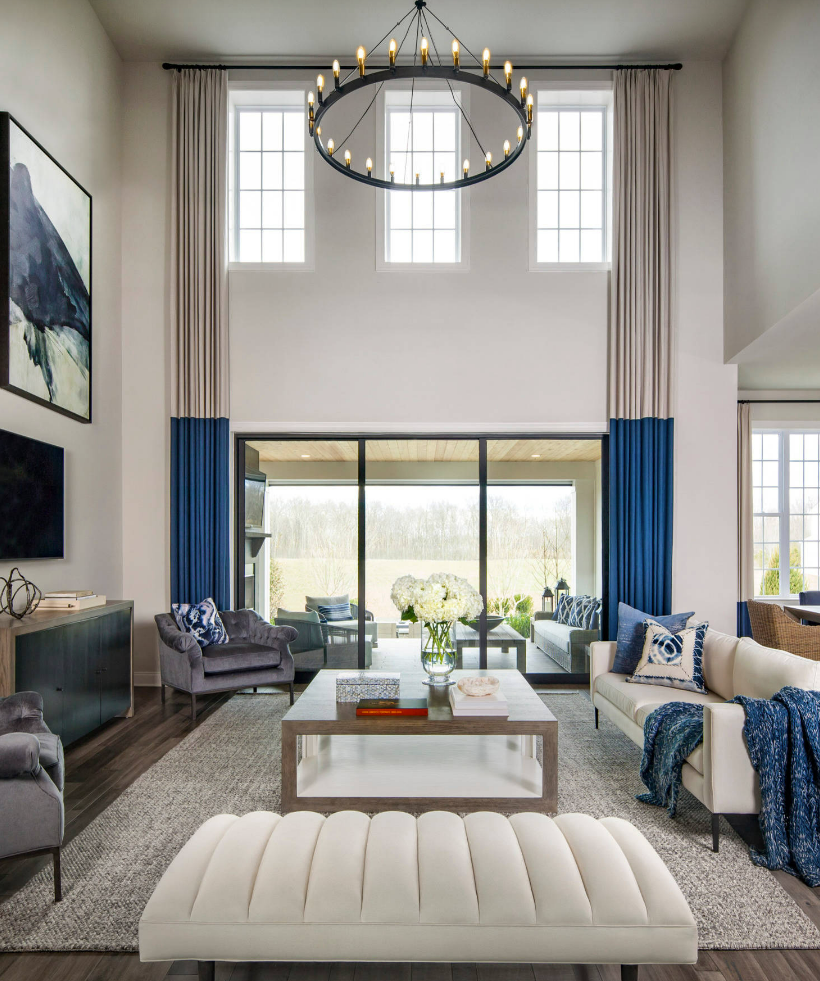
Considering the scale and weight of the curtains, it is advisable to invest in high-quality hardware that will stand the test of time and last the lifetime of the house itself.
Depending on the look you’ve chosen, you need to select and set up your hardware. So, if you want floor-to-ceiling curtains, you can mount the pole or the tracks on the wall or the ceiling. To facilitate ease of operation, we recommend investing in sturdy traverse rods/tracks. Also, consider motorizing them so that the operation becomes more convenient and time-saving and the experience with your sliders truly magical and memorable.
If you’re hanging the curtains just above the doors, make sure you hang them at least 6 inches above the trim. This positioning helps to curtail all light leaks from the top.
And no matter which point you hang them from, extend the pole/track at least 6 inches on both sides so that the stacking room does not take away from the door space. When you open the curtains, you’ll have the entire glazed portion free for viewing.
Final Notes
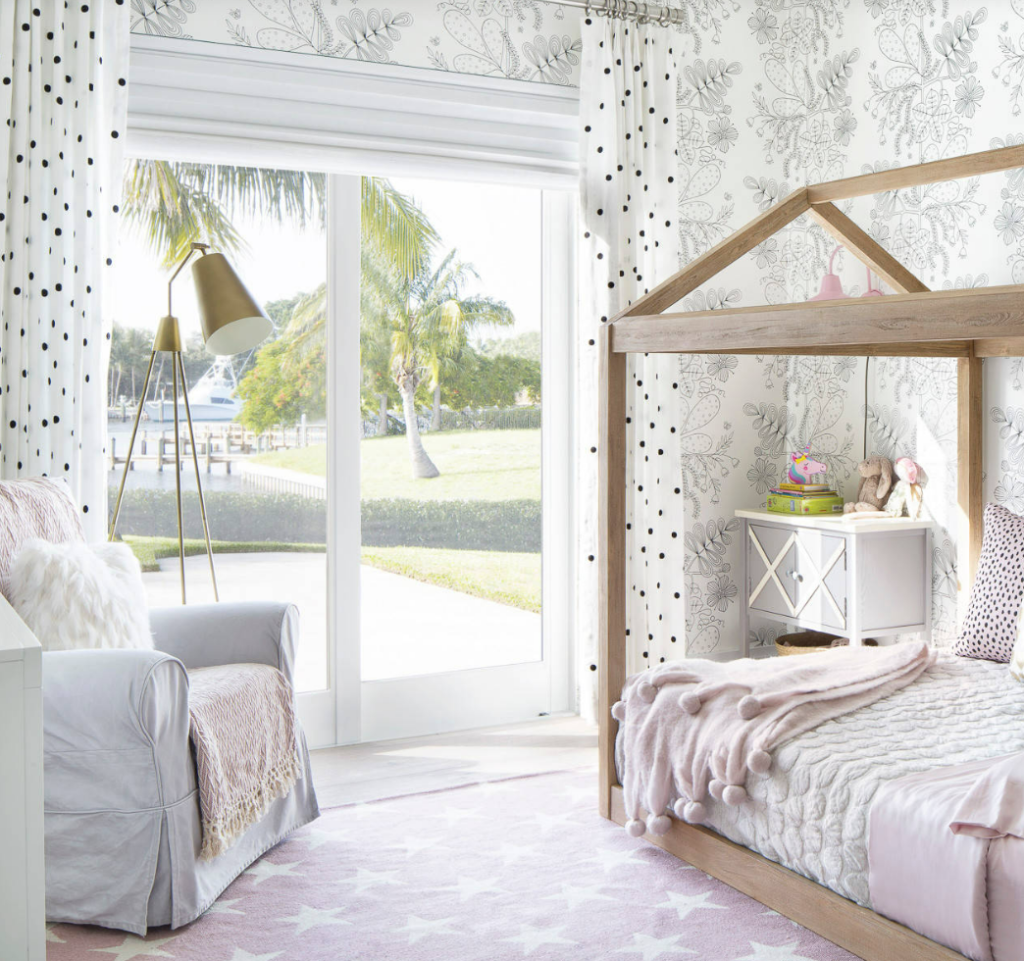
We hope this blog has sufficiently enriched you with styling tips for your sliding glass door curtains. Pay attention to all the matters covered here and you’re sure to get them right at the first take. Be assured that Spiffy Spools’ curtains and drapes collections are never going to run you out of choice or enough guidance to meet your design aspirations. So, browse our site and race your creativity to style your very own sliding glass door curtains.
READ MORE: ROMAN SHADES FOR GLASS SLIDING DOORS

